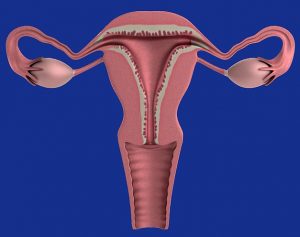What is Endometriosis?

Endometriosis is a complex disease process commonly results in pelvic pain and infertility. It is one of the most common female reproductive conditions, with 50% of female infertility patients estimated to have it.
The Endometrium and the Menstrual Cycle
Around the time of ovulation, the endometrium (inside lining of the uterus) grows thick with blood vessels, glands, and stored nutrients to allow a fertilized egg to implant and grow. If fertilization does not occur, the endometrial tissue sheds as menstrual flow to mark the beginning of the next cycle. Progesterone and estrogen control the growth and stabilization of the endometrial tissue. The uterus may not maintain a pregnancy if a woman’s doesn’t produce enough progesterone and estrogen.
How Endometriosis Starts
Endometriosis most likely starts with normal menstrual flow that spills back through the tubes and into the pelvis. This tissue then becomes adherent to the pelvic walls and floor, depending on the interplay of the woman’s immune system and inflammatory response. Responding to her own hormones, the endometriosis is allowed to grow and spread on the pelvic surfaces including the ovaries and tubes, and leads to a cycle of growth and inflammation. This results in the symptoms of painful menses, pain with intercourse, generalized pelvic discomfort, chronic pain, pelvic scar tissue and infertility. Alternatively, there may be no symptoms at all. While there are no identifiable markers that would make the diagnosis detectable by a blood test, promising developments are on the horizon, attempting to interrupt the complex pathways in its development.
Diagnosing Endometriosis
The doctor performs a laparoscopy to diagnose and treat endometriosis through direct visualization. He will try to destroy as much of the disease as possible, including endometrial cysts within the ovary.
‘Chocolate cysts,’ detected via ultrasounds, are often associated with advanced endometriosis. The physician will prescribe the best treatment, including medications such as progestins ( synthetic progesterone hormones) and leuprolide acetate ( monthly injection), both alone or in combination with surgery. Dr. Blotner prefers the CO2 laser method for laparoscopic removal because it causes minimal effects on the surrounding normal tissue.
Endometriosis Treatment Options
We must evaluate each woman’s clinical situation by her symptoms and treatment goals to guide her individualized therapy. If she wants to conceive, we must evaluate her ovarian reserve, which we determine by her hormone levels. Female hormone levels include AMH, cycle days 2-3 FSH, LH, and estradiol, and an antral follicle count (the number of tiny eggs carrying cysts in the ovaries) visualized by transvaginal ultrasound.
These factors may help the woman and her physician decide on the best treatment approach, as surgery could decrease the ovarian reserve, depending on the severity of the disease. She may wish to attempt more advanced fertility therapy and freeze her eggs or embryos through in vitro fertilization before directed endometriosis treatment.

